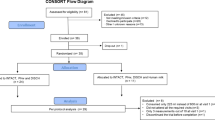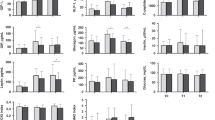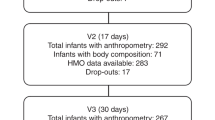Abstract
Background/Objectives:
Consumption of formula in place of human milk may produce differences in postprandial glycaemia and insulinaemia that contribute to metabolic programming in the first year of life. The objective of the current study was to determine glycaemic and insulinaemic responses to human milk compared with a typical commercial formula, and then compare 11 other formulas.
Subjects/Methods:
On separate mornings in random order, 10 healthy breastfeeding mothers consumed 25 g available carbohydrate portions of their own milk, a formula and reference food (25 g glucose on two occasions). In the second study, 10 different healthy subjects consumed 25 g available carbohydrate portions of 11 different commercial formulas and three reference foods (25 g glucose on three occasions). Fingerpick blood samples were taken at regular intervals over 2 h, and the glycaemic index (GI) and insulin index determined according to a standardised protocol.
Results:
There were no significant differences in postprandial glycaemia or insulinaemia after human milk vs a typical formula (P=0.3). Both produced a low GI (mean±s.e.m.: 38±7 vs 34±7, respectively) and high insulin index (87±14 vs 94±16). The GI and insulin indices of the other formulas ranged from 18±3 to 67±6 and 53±9 to 209±33, respectively.
Conclusions:
Human milk and a typical formula elicit similar postprandial glycaemic and insulinaemic responses, but there is a wide range of responses to other formulas.
This is a preview of subscription content, access via your institution
Access options
Subscribe to this journal
Receive 12 print issues and online access
$259.00 per year
only $21.58 per issue
Buy this article
- Purchase on Springer Link
- Instant access to full article PDF
Prices may be subject to local taxes which are calculated during checkout



Similar content being viewed by others
References
Walker A . Breast milk as the gold standard for protective nutrients. J Pediatr 2010; 156: S3–S7.
World Health Organization statement Exclusive Breastfeeding For Six Months Best For Babies Everywhere. World Health Organization: Geneva, Switzerland, 2011.
Owen CG, Martin RM . Does breastfeeding influence risk of type 2 diabetes in later life? A quantitative analysis of published evidence. Am J Clin Nutr 2006; 84: 1043–1054.
Singhal AL, Lanigan J . Breastfeeding, early growth and later obesity. Obes Rev 2007; 8: 51–54.
Koletzko B, von Kries R, Monasterolo RC . Can infant feeding choices modulate later obesity risk? Am J Clin Nutri 2009; 89: 1502–1508.
Hörnell A, Lagström H, Lande B, Thorsdottir I . Breastfeeding, introduction of other foods and effects on health: a systematic literature review for the 5th Nordic Nutrition Recommendations. Food Nutr Res 2013; 57: 10.
Horta BL, Victora CG . Long-Term Effects of Breastfeeding: a Systematic Review. World Health Organization: Geneva, Switzerland, 2013.
Lönnerdal B, Havel PJ . Serum leptin concentrations in infants: effects of diet, sex, and adiposity. Am J Clin Nutr 2000; 72: 484–489.
Butte NF . Impact of infant feeding practices on childhood obesity. J Nutr 2009; 139: 412S–416S.
Shields L, Mamun AA, O’Callaghan M, Williams GM, Naiman JM . Breastfeeding and obesity at 21 years: a cohort study. J Clin Nurs 2010; 19: 1612–1617.
Brion MA, Lawlor DA, Matijasevich A, Horta B, Anselmi L . What are the causal effects of breastfeeding on IQ, obesity and blood pressure? Evidence from comparing high-income with middle-income cohorts. Int J Epidemiol 2011; 40: 670–680.
Fall CHD, Borja JB, Osmond C, Richter L, Bhargava SK . Infant-feeding patterns and cardiovascular risk factors in young adulthood: data from five cohorts in low and middle income countries. Int J Epidemiol 2011; 40: 47–62.
Martin MM, Patel R, Kramer MS, Guthrie L, Vilchuk K . Effects of promoting longer-term and exclusive breastfeeding on adiposity and insulin-like growth factor-1 at age 11.5 years—a randomized trial. JAMA 2013; 309: 1005.
Beyerlein A, von Kries R . Breastfeeding and body composition in children: will there ever be conclusive empirical evidence for a protective effect against overweight? Am J Clin Nutr 2011 94 (suppl), 1772S–1775S.
Bornet FRJ, Jardy-Genneteir AE, Jacquet N, Stowell J . Glycaemic response to foods: Impact on satiety and long-term weight regulation. Appetite 2007; 49: 535–553.
Brand-Miller JC . Importance of glycemic index in diabetes. Ame J Clin Nutr 1994; 59: 747–752.
Augustin LS, Franceschi S, Jenkins DJ, Kendall CW, La Vecchia C . Glycemic Index in chronic disease; a review. Eur J Clin Nutr 2002; 56: 1049–1071.
Jenkins DJ, Kendall CW, Augustin LS, Franceschi S, Hamidi M, Marchie A . Glycemic index: overview of implications in health and disease. Am J Clin Nutr 2002; 76: 266S–273S.
Gunnerud U, Holst J, Ostman E, Bjorck I . The glycemic, insulinemic and plasma amino acid responses to equi-carbohydrate milk meals, a pilot-study of bovine and human milk. Nutr J 2012; 11: 83.
International Standards Organisation. ISO 26642-2010 Food Products: Determination of the Glycaemic Index (GI) and Recommendation for Food Classification. International Standards Organisation: Geneva, Switzerland, 2010.
Cooper AR, Barnett D, Gentles E, Cairns L, Simpson JH . Macronutrient content of donor human breast milk. Arch Dis Child Fetal Neonatal Ed 2013; 98: F539–F541.
Wojcik KY, Rechtman DJ, Lee ML, Montoya A, Medo ET . Macronutrient analysis of a nationwide sample of donor breast milk. J Am Diet Assoc 2009; 109: 137–140.
Jenkins DJ, Wolever TM, Taylor RH, Barker H, Fielden H, Baldwin JM . Glycemic index of foods: a physiological basis for carbohydrate exchange. Am J Clin Nutr 1981; 34: 362–366.
Barker DJ . The fetal and infant origins of adult disease. BMJ 1990; 301: 1111.
Gilloteau P, Zabielski R, Hammon C, Metges C . Adverse effects of nutritional programming during prenatal and early postnatal life, some aspects of regulation and potential prevention and treatments. J Physiol Pharmacol 2009; 60: 17–35.
McMillen C, Robinson JS . Developmental origins of metabolic syndrome: prediction, plasticity, and programming. Physiol Rev 2005; 85: 571–633.
Liljeberg-Elmståhl H, Björck I . Milk as a supplement to mixed meals may elevate postprandial insulinemia. Eur J Clin Nutr 2001; 55: 994–999.
Nilsson M, Stenberg M, Frid AH, Holst JJ, Björck IM . Glycemia and insulinemia in healthy subjects after lactose-equivalent meals of milk and other food proteins: the role of plasma amino acids and incretins. Am J Clin Nutr 2004; 80: 1246–1253.
Wright CJ, Atkinson FS, Brand-Miller JC . Glycaemic and Insulinaemic responses to commercially available infant formulas. Australas Med J 2010; 3: 865–876.
Koletzko B, Baker S, Cleghorn G, Neto UF, Gopalan S . Global Standard for the Composition of Infant Formula: recommendations of an ESPGHAN Coordinated International Expert Group. J Pediatr Gastroenterol Nutr 2005; 41: 584–599.
Brand-Miller JC, McVeagh P, McNeil Y, Messer M . Digestion of human milk oligosaccharides by healthy infants evaluated by the lactulose hydrogen breath test. J Pediatr 1998; 133: 95–98.
Acknowledgements
This study was supported by The University of Sydney and internally funded.
Author Contributions
CJW was responsible for the preparation of foods, collection, analysis and interpretation of data and writing of the manuscript. FSA was responsible for analysis of the data and writing of the manuscript. NR prepared the food and collected the data. AEB conceived the study and wrote the manuscript. JCB-M conceived the study, interpreted the data and wrote the manuscript.
Author information
Authors and Affiliations
Corresponding author
Ethics declarations
Competing interests
JCB-M is a co-author of The Low GI Diet Revolution (Marlowe and Co., New York, NY, USA, 2005) and co-author of The New Glucose Revolution book series (Hodder and Stoughton, London, UK; Marlowe and Co., New York, NY, USA; Hodder Headline, Sydney, Australia; and elsewhere) and the director of a not-for-profit GI-based food endorsement programme in Australia. FSA manages the University of Sydney GI testing service, is a co-author of the New Glucose Revolution book series (Hodder and Stoughton, London, UK; Marlowe and Co., New York, NY, USA; Hodder Headline, Sydney, Australia; and elsewhere) and the director of a not-for-profit GI-based food endorsement programme in Australia. The remaining authors declare no conflict of interest.
Rights and permissions
About this article
Cite this article
Wright, C., Atkinson, F., Ramalingam, N. et al. Effects of human milk and formula on postprandial glycaemia and insulinaemia. Eur J Clin Nutr 69, 939–943 (2015). https://doi.org/10.1038/ejcn.2015.29
Received:
Revised:
Accepted:
Published:
Issue Date:
DOI: https://doi.org/10.1038/ejcn.2015.29



